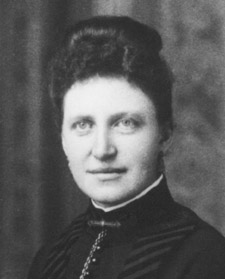Maria Johanna Sørensen (1857-1929)

|
| Maria Johanna Sørensen, 1886 |
Marie Johanne Sørensen (see Notes on Maria's name) was born in 1857 in the hamlet of Gram, Vejle County, Denmark, the daughter of Else Nielsen (Nielsdatter) and Jens Jørgen Sørensen. Her father abandoned the family when Maria was 12 years old. The family (Else and four children) were scraping along in poverty in the city of Horsens when they were introduced to the Church. Starting with Else in 1877, all were eventually baptized. (Maria was baptized in 1878.) They began to emigrate to Utah, in stages, with Maria arriving about 1885. Prior to this, Maria had already become mother to two children, Niels and Emma, but for reasons unknown to us, she chose not to marry the father of either one, even though both men desired it. Maria, working as domestic help in Salt Lake City, became acquainted with another Danish immigrant, Hans Madsen, and in 1886 he asked her to be his wife (in polygamy).
For a continued overview of Maria, Hans, and their children, see Family of Hans and Maria Madsen.
Although, no one wrote a "Life History" of Maria, per se, there are references to portions of her life in the recorded memories and histories of other members of her family:
- "This is My Life", by her son, Harry
- Biography of Emma Vissing Lauper (Maria's daughter)
- Memories, by her granddaughters, Irene and Helen Williams
- History of Else Nielsen Jacobsen, (Maria's mother)
- The Madsen Family History, a book of Madsen family history
- Julius Sorensen letter, after her death
Notes on Maria's name
Is her name "Maria Johanna" or "Marie Johanne"?
Maria's christening record, from the parish church at Rårup, actual indicates a spelling of "Marie Johanne". The difference from our "usual" spelling of "Maria Johanna" is probably due to the differences between Danish and English pronunciation. English has many words, including names, with a final "silent e". The name "Marie", one of the many variations of the standard English name "Mary", would be recognized by many English speakers as the French version of Mary, pronounced with a final "silent e". However, in Danish, the final "e" is not silent. It's pronunciation corresonds most closely with what English speakers would write "Maria". (The same thing goes for "Johanne" vs. "Johanna".) The difference may also be attributed to laxness in standardized spelling; in Danish, you will see the name written both "Marie" and "Maria", which are pronounced the same.
Why is her last name "Sorensen" when her father's name is not Soren?
It is noteworthy to see that Maria's maiden surname, "Sorensen" (or, as it is properly spelled in Danish, "Sørensen") is also the surname of her father, Jens Jørgen Sørensen. Traditionally, the Scandanavian countries used a naming convention where each person had one or two given names (a "first" name and a "middle" name), plus a "patronym", or indicator of their father, rather than
a family surname. Thus, Maria's father, had the patronym of "Sørensen" because his father was named "Søren", that is, he was "Søren's son". This convention began to change in the latter half of the nineteenth century to conform with the modern convention shared by many cultures: a family surname is passed from generation to generation. It is most likely that as a newborn, Maria was referred to as "Marie Johanne Jensdatter", since she was the daughter of a man named "Jens". In 1857, the rural community where she was born probably continued to use that tradtional convention. However, Danish records don't typically record the full name of a woman until she marries and/or bears a child. In this case, at the birth of her daughter Emma, 24 years later in the urban setting of Vejle, her last name is listed as "Sørensen". We can guess that it is recorded so because either she or society had decided to begin passing along her father's patronym as her unchanging surname.

